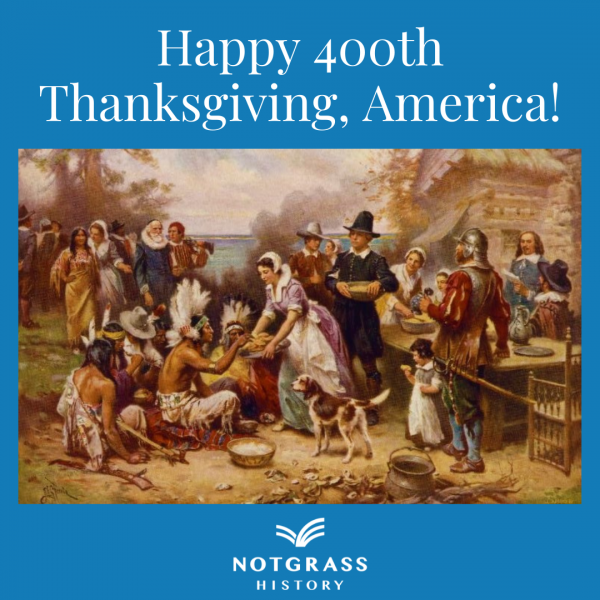Happy 400th Anniversary of Thanksgiving! A History of Thanksgiving in America
In the autumn of 1621, the Pilgrims of Plymouth gathered in their harvest. According to a letter written by Edward Winslow in 1621, Governor William Bradford sent four men hunting for fowl so that they could have a special time of rejoicing. During the celebration, the Pilgrims enjoyed feasting and recreation, including “exercising their arms (guns).” They hosted about 90 men of the Wampanoag nation, including their chief, Massasoit, for three days of celebration. During the feasting, the Wampanoag went hunting and brought back five deer as gifts for Pilgrim leaders.
In the early 1900s, Jean Leon Gerome Ferris created a series of historical paintings called Pageant of a Nation. This is his depiction of the gathering of the Pilgrims and the Wampanoag in 1621.

The Pilgrims of Plymouth observed only three kinds of holidays. Each Sunday they observed what they referred to as the Sabbath by worshipping God and hearing sermons. They also held days of Fasting and Humiliation and days of Thanksgiving. The Pilgrims called for a day of Fasting and Humiliation when they felt God’s hand of judgment and for a day of Thanksgiving when they saw special blessings. They usually held days of Fasting and Humiliation and days of Thanksgiving on Thursdays, the regular day for their midweek church meeting. During the summer of 1623, they held an official day of Thanksgiving after God sent a rain that saved their crops. Governor Bradford wrote about the Wampanoag’s astonishment over this blessing from God.
Over the years, settlements throughout New England began having annual Thanksgiving holidays during the autumn. Community leaders would simply announce a date and residents would start preparing for a celebration. By the middle of the 1600s, the New England custom of having an annual Thanksgiving was firmly established.
In 1777 Americans were in the midst of the American Revolution. The Continental Congress declared a day of Thanksgiving after the American victory over the British at the Battle of Saratoga. The Continental Congress declared a day of Thanksgiving every year through the end of the war in 1783.
In 1779, young Juliana Smith wrote a letter to a friend telling about her family’s Thanksgiving celebration. From this letter, we learn:
- Before the meal, the Smiths went to church to give thanks to God.
- Smith family members took turns hosting the dinner each year, and guests brought food.
- They were unable to have beef in 1779 because the Continental Army needed it.
- Instead of beef, they had venison, pigeon pasties, pork, turkey, and goose.
- For dessert they had pumpkin pie, apple tarts, and Indian pudding.
- While still sitting at the table, some of the men sang hymns and ballads.
- Then the group sang a hymn and someone led them in prayer.
- After dinner, they crowded around the fire to tell stories.
Early in our history as a nation, presidents declared national days of Thanksgiving. George Washington did so in 1789 and 1795. John Adams made Thanksgiving proclamations in 1798 and 1799. James Madison called two national days of Thanksgiving during 1815.
Though Thanksgiving was not a national holiday during the early 1800s, Americans continued to celebrate the feast mainly in New England. There each state declared an annual Thanksgiving, usually in November. As New Englanders moved west, they carried the Thanksgiving tradition with them. Other states began to celebrate the holiday, too. Southern states were the last to adopt the practice.
The popular Godey’s Lady’s Book was America’s first magazine devoted entirely to articles of special interest to women. The magazine published pieces by many famous American writers, including Nathaniel Hawthorne, Henry Wadsworth Longfellow, and Harriet Beecher Stowe. In 1837 Sarah Josepha Hale became its editor. Each November from 1846 to 1863, Hale wrote editorials urging the U.S. government to declare Thanksgiving a national holiday. In 1863 President Lincoln declared the last Thursday in November to be Thanksgiving Day. Afterwards, each President followed his example.
In 1939 President Franklin Roosevelt declared Thanksgiving to be the next to last Thursday in November. Merchants had asked him to change the date so that the Christmas shopping season would last longer. The date change caused an uproar and some people began to call the holiday “Franksgiving.” President Roosevelt admitted his mistake, and in 1941 he signed a bill establishing the fourth Thursday in November as the official Thanksgiving Day for the United States.
Happy 400th Thanksgiving, America.
I have many reasons to be thankful on this Thanksgiving Day. You are one of them, Mama. At our midweek Bible study, held on Tuesday this week, Gary led us in prayer. He thanked God for His blessings and asked Him to help us to enjoy them and take care of them. I loved that encouragement to be thankful for God’s blessings and also to enjoy them and take care of them.
Enjoy this historic Thanksgiving, Mamas.
Enter His gates with thanksgiving,
And His courtyards with praise.
Give thanks to Him, bless His name.
For the Lord is good;
His mercy is everlasting
And His faithfulness is to all generations.
Psalm 100:4-5


